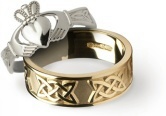Blog Categories
Blog CategoriesTop 5 Symbols of the History of Ireland
Are you good at spotting Irish heritage?
The trusty green shamrock is known around the world, along with the green, white and gold of the Irish flag, but here are some other Irish symbols that represent the history of Ireland.
 |
| Entrance to Newgrange, County Meath |
Circle of Life Swirl
This one has worldwide and global resonance but when it comes to Irish and Celtic meaning, if you spot this simple swirl - look again. The Celtic swirl shape can be seen on Neolithic structures, which were built throughout Ireland thousands of years ago. The shape has no beginning and no end - it represents the unwinding path we all travel on through this life. It's regularly used in jewelry and art as a beautiful embellishment.

|
| Round Tower at Monaterboice, County Louth |
Round Towers and Tall Tales
The ethereal Glendalough in County Wicklow is an image that is seen in photographs most often but there are round towers scattered throughout Ireland. From the 6th century as Christianity spread, great centres of study and prayer were set up all over the country by monks - often in beautiful and secluded locations. Originally bell towers and look out points, they then became used as places for the storage of food and for refuge against battles. They're known as a unique contribution to world architecture.
 |
| General Post Office in Dublin City Centre |
GPO - Most famous post office in the world
Not many countries boast a post office as one of their most famous landmarks. Dublin's O'Connell Street is home to the GPO or General Post Office. This was the scene of the start of the Easter Rising in 1916 which triggered the War of Independence that eventually brought about the setting up of the modern Irish state. The building was almost destroyed by fire and the subsequent execution of the leaders of the rising provoked great anger.
Look out for Leprechauns
The little bearded men in the coats and hats are all around, according to Irish folklore. Mischief makers and fun starters, they're a symbol of Ireland around the world. The word leprechaun comes from the ancient Celtic god Lugh. He was originally the god of sun and light and then became a warrior of Ireland in ancient times. They're our claim to fame and if you look closely you might spot one. All you have to do is believe!
 |
The Golden Harp
Back when Henry VIII assumed the position of the King of Ireland in 1531, he immediately declared the harp as the national symbol of Ireland. Since then the harp has been considered the heraldic symbol of the country. In old Gaelic society, chieftans would never go far without their companions, which included a bard and harper. As the Irish kingdoms declined, the music of the harp grew more and more silent and then over the decades became a symbol of resistance to the Crown. Many people think that green is the colour of Ireland but the harp was originally set on a dark blue background. The National Library of Ireland explains that this is to represent the sovereignty of Ireland. In recent years, many people may recognise it as the symbol of Guinness!
